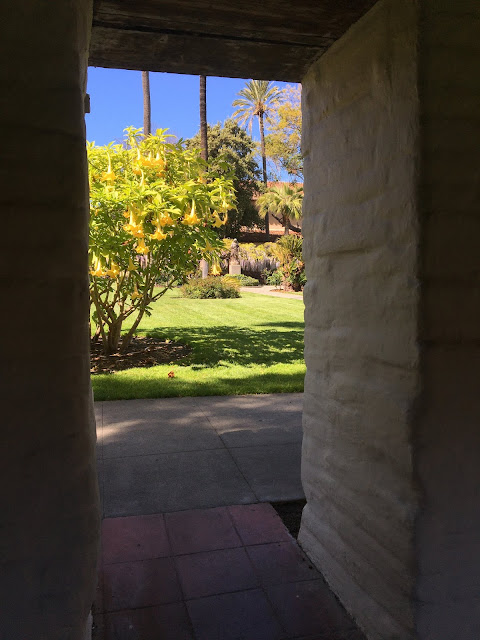Urban University Walk Through History: Santa Clara University
In keeping with the idea of neighborhood walks, Santa Clara University is only a few minutes from my house and offers a beautiful, peaceful space to enjoy. Santa Clara University is a private Jesuit college founded in 1851, making it California’s oldest operating institution of higher learning. A central part of the campus is Mission Santa Clara de Asis, established by Father Junipero Serra on January 12, 1777. It was the eighth California mission built of twenty-one stretching from San Diego to Sonoma. Father Serra founded nine of the missions until his death in 1784, just two years after the founding of Mission Buenaventura in 1782. It was also the first California Mission to honor a female saint, St. Clare of Assisi, a nun from the 1200's who worked closely with Saint Francis. The mission, as you see it today is the fifth location for the Santa Clara de Asis Mission. Due to numerous disasters from floods, earthquakes and fires, the mission was forced to relocate each time until it finally found its permanent home.
The interior of the church is beautiful, unfortunately entrance to the church is temporarily closed for both mass services and visitation due to the current COVID-19 restrictions but there is still much to see outside the mission. The grounds of the historical area and main campus are beautifully landscaped and well maintained. With students no longer on campus, currently taking part in online distance learning, there were very few people on campus. It was a peaceful, serene walk even in these harried times.
 |
| Fountain off Palm Drive with Mission Santa Clara de Asis in the background. |
The interior of the church is beautiful, unfortunately entrance to the church is temporarily closed for both mass services and visitation due to the current COVID-19 restrictions but there is still much to see outside the mission. The grounds of the historical area and main campus are beautifully landscaped and well maintained. With students no longer on campus, currently taking part in online distance learning, there were very few people on campus. It was a peaceful, serene walk even in these harried times.
In one part of the historic area of campus the Adobe Lodge can be found. The Adobe Lodge built in 1822, is the oldest structure on campus. The corridor along the south wall reflects the Mission-style architecture of the time with the walls of adobe, tiled roofs and beautiful courtyards. The Adobe Lodge serves many purposes from weddings to smaller gatherings of faculty, staff and their guests. It's rustic beauty takes you back to another time.
 |
| Walking the corridor presented doorways and archways that lead to beautifully renovated rooms or lush courtyard gardens. |
 |
| The tile work on the steps also caught my eye. |
 |
| One of the open doorways leading to the courtyard with a very full yellow trumpet flower tree. |
As you continue to the end of the adobe wall, you can see the unpainted bricks as the wall in its natural form. I also read on one of the campus maps that part of the wall was used as a kitchen and smokehouse.
 |
| There was no signage next to this gaping hole. Perhaps it might have served in some kitchen capacity. |
Near the adobe wall are two grinding stones used back in times of the mission.
The walkway that parallels the south side of the current church location. This "concrete design marks the hallway through the east wing of the 1922 mission leading to the courtyard" according to the campus map.
Finally the mission itself. This is a view of the bell tower. The bell tower holds three bells of the mission period (cast 1798, 1799, and 1805). Beside the tower, you'll notice a small rust colored bell on a staff. The bells were a project of the Women's Club of California. Back in 1906 they decided to recognize the historic El Camino Real, marking it with bells similar to this one pictured so it would not be lost. The El Camino Real was the foot or horse path that lead from mission to mission. By 1940 they had over 400 bells placed along the route.
 |
| The church front facade has three bronze statues. The middle statue, pictured here, is of Saint Clare. |
This tall wooden cross stands at the front of the mission. In its base are encased remnants of the original cross dating back to 1977. The cross had been moved from the each of the previous locations to its current spot.
The beautiful rose garden is to the right of the church as you face it. It is the location of the mission cemetery. From the self-guided walking tour of Mission Santa Clara de Asis,"These walls outline the gravesites of thousands of Ohlone, Californios, and Anglos buried here from 1822 to 1851. The graves actually extend well beyond these walls. "
 |
| This life-sized statue of Father Junipero Serra is located behind the cemetery. |
Near the De Saisset Museum is the Saint Clare Memorial Garden. This small, enclosed garden is modeled after medieval gardens of that time called herbariums. The vegetables and flowering plants were those traditionally associated with the Virgin Mary. All these plants are those that Clare would have found familiar as those used during her life.
Walking around Santa Clara University was the perfect neighborhood stroll during this time of social distancing. The gorgeous flowering displays and quiet spaces provided some peace of mind for this city dweller.



















Comments